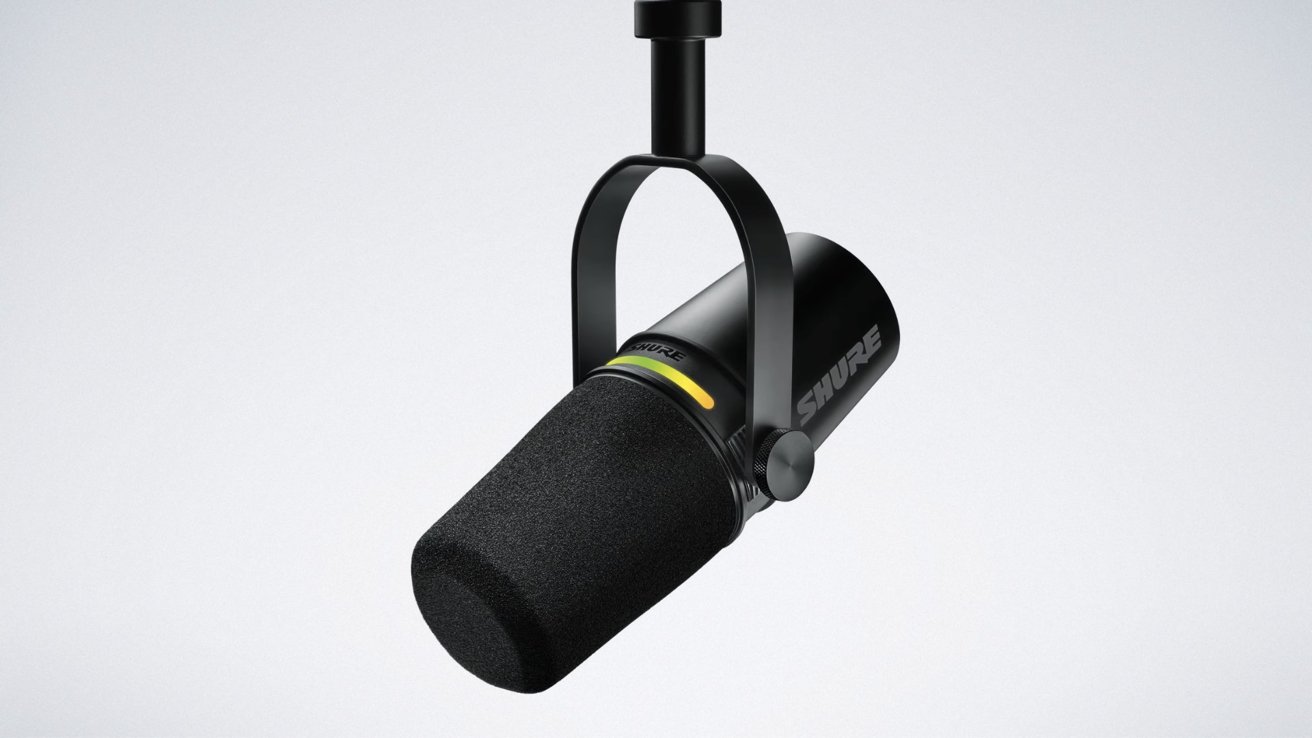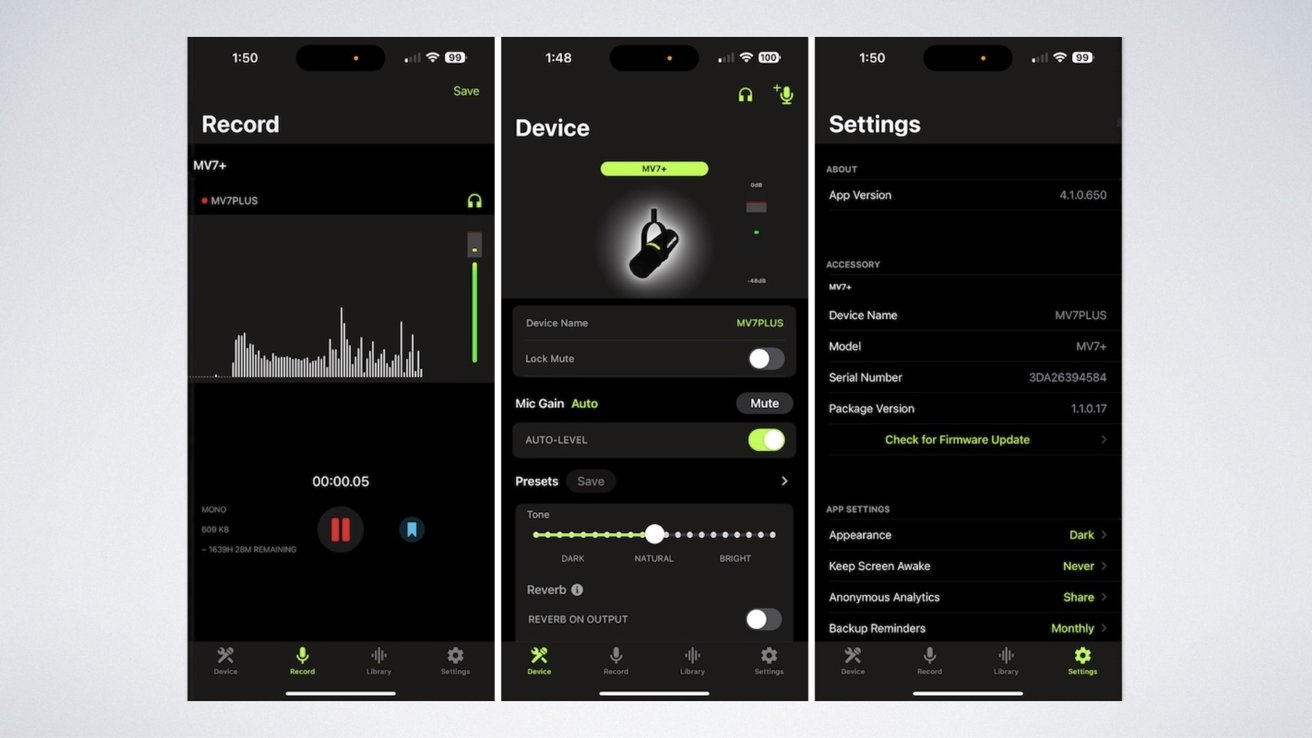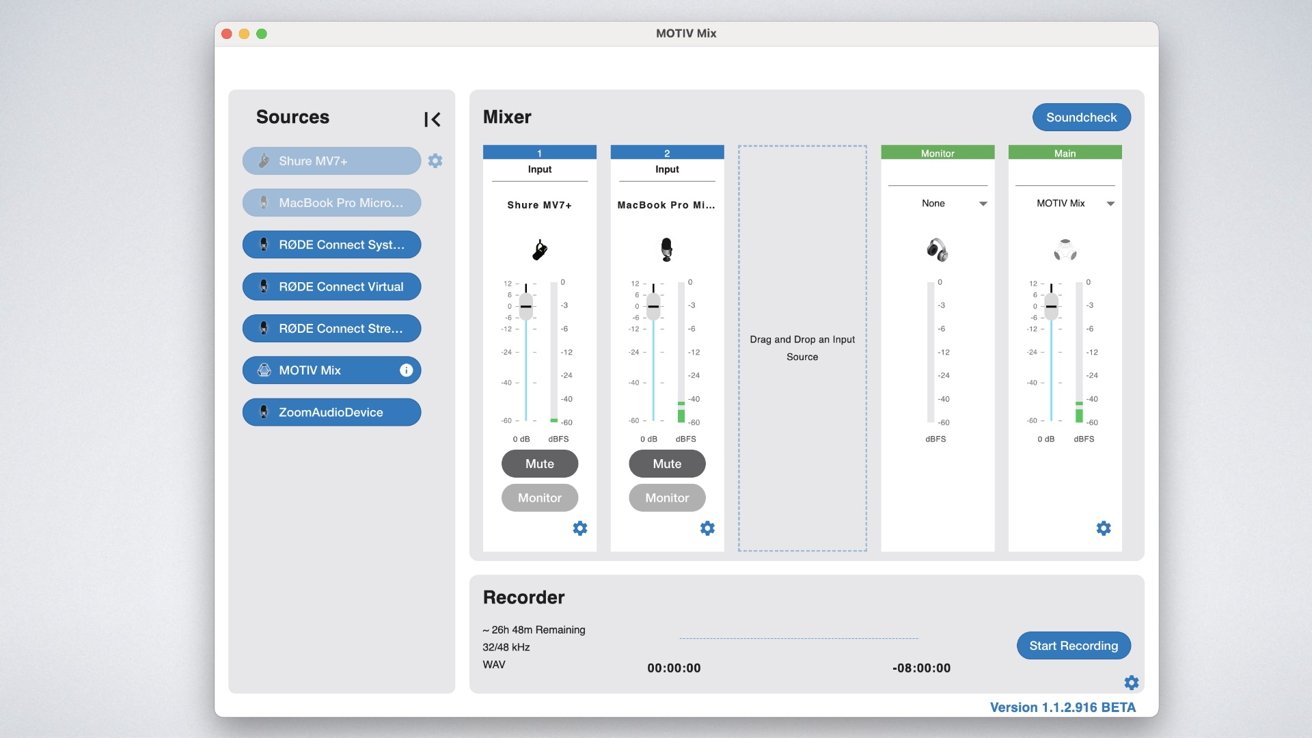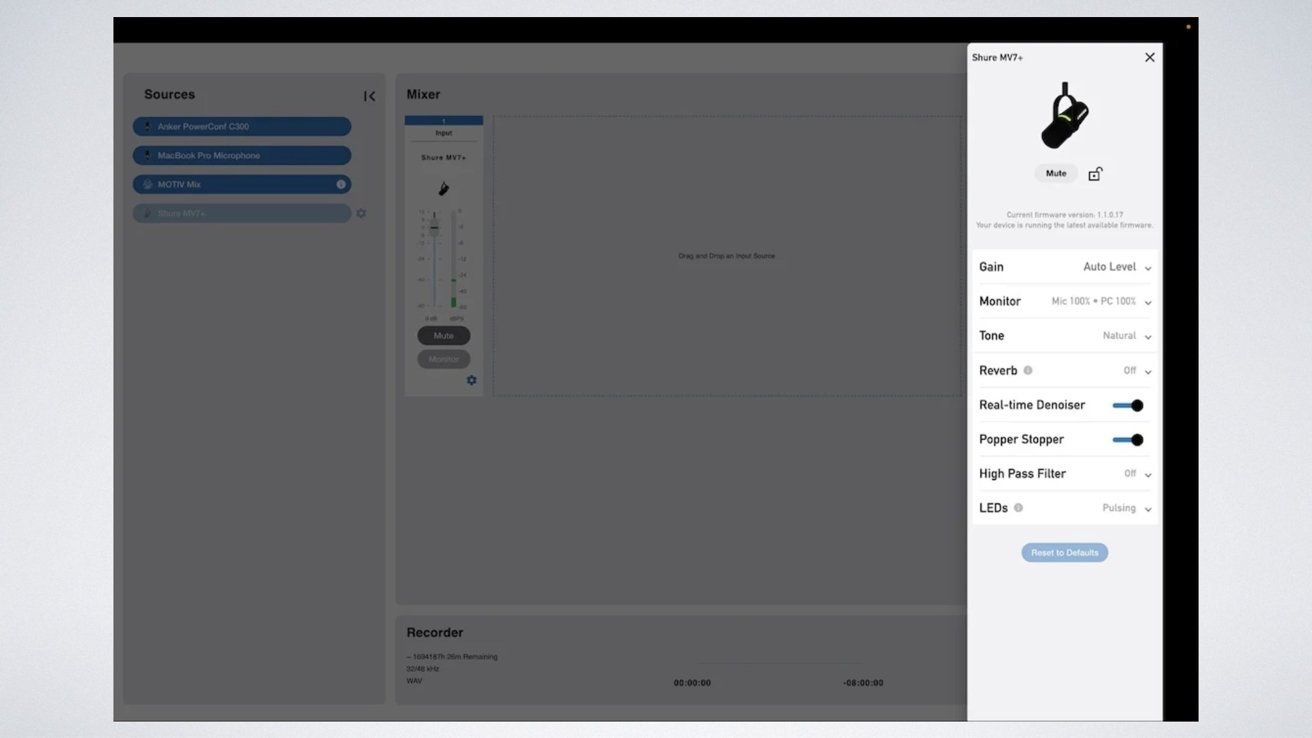Shure MV7+ microphone review: an excellent midrange workhorse
The latest podcasting mic from Shure is an all-around winner -- especially for those recording in less-than-ideal locations.

The Shure MV7+, in black, with its included yoke.
The Shure MV7+, an improved version of previous excellent Shure vocal mics, is another feather in the company's cap. Only a few minor flaws keep it from being perfect, but the quibbles are pretty minor.
Out of the box, the mic offers a solid single-person experience for either digital or analog recording. The sound, which can be further tailored through software, is natually warm and smooth.
It comes with a foam windscreen that also protects against "pops and plosives," and the downloadable software for Mac, Windows, iPhone/iPad, and Android goes even further. In addition to software protection from pops, light background noise and room echo can be digitally eliminated or greatly reduced.
A podcaster's dream mic
This is great news for those who don't have a dedicated room with sound-deadening foam. If you have any kind of a decent speaking voice, the combination of software and hardware will make you sound like a pro.
The Shure MV7+ retails for $279, though it can sometimes be found for less both at music stores and online. You can pay less for a mic, but you'll get less-accurate sound.
You can pay a lot more as well, but mics priced higher than $300 tend to be designed for full-range sound, and less for straight vocal recording. The microphone comes with either a white or black body color, and the included yoke matches that color.
Buyers should be aware that the MV7+ doesn't have settings for two-person or roundtable recordings -- the sound capsule inside is aimed right at the top of the mic. Some competitors, like the Yeti Pro, can be a better choice when you want to record more than one person with a single mic.
A 16.8 million color LED band around the middle of the mic makes for easy muting, and the colorful display can be turned off or held steady through the software. By default, it's green when active and red when muted, but is customizable, and gives users a cool visual indicator of levels that looks great if you're on camera.
By putting both a USB-C and analog connection at the bottom of the mic, the MV7+ can work easily in a variety of scenarios. A generous three-meter (9.8-foot) USB-C to USB-C cable is included in the package.
It should be noted that a USB-C to Lightning cable will be needed if your recording to a device that only has a Lightning port. There is an analog headphone minijack at the bottom of the mic for real-time monitoring.
The included yoke uses the standard screw size for boom arms and desktop stands if you already have either of those. You can start recording as quickly as you can attach the mic to your rig, plug in the USB-C cable, and open your recording software.
The mic and downloadable software to customize it also work very well on Android phones, iPhones and iPads with USB-C imput, but a USB-C to Lightning adapter will also work. The mic works on other recording apps for all platforms, but the sound-sculpting features require the free Motive software.
The weak spots
Oddly, the base package only includes a swiveling yoke designed for mounting -- a desktop stand costs extra, as does a Shure-branded boom arm. Not including a way to start using the mic immediately without having an existing mount is, in our view, an mistake that first-time buyers will not be happy about.
The MV7+ is also, of course, not quite as rich and smooth-sounding as the venerated Shure SM7B analog mic, which sells for $399. That said, it is a notable improvement on 2022's MV7 and most of the competition at this price point.
The Motiv Mix software for Mac and Windows is functional and very useful, but wastes a lot of screen space. Shure clearly put in more time and effort on the design of the iPhone/iPad and Android versions of the Motiv app, which also work very well.

The Shure Motiv Mix software for the iPhone.
It's also fairly annoying that, having bought the mic, you must register with Shure by providing contact details before you can download the Mac or Windows software. You can opt-out of receiving promotional emails, but you can't be sure that Shure isn't going to "share" your information with partners.
You do not have to use the Motiv software -- the mic works great right out of the box with any other recording software. However, if you want the extra digital features like the Popper Stopper, the cancellation of background noise, optional reverb effects, or shaping your specific preferred EQ, you'll want to use the Motiv software.
Digital and analog options
You can also use Motiv Mix desktop app to record multiple mics simultaneously -- it detected every brand I could throw at it -- or if you want to record system sounds on your Mac. You can do that latter trick by going to Settings -> Sound -> Output & Input, and choosing Motiv Mix as the input.
When using other or multiple mics, the software let me adjust level settings for each one separately, but any effects and custom EQ could only be set for the MV7+, of course. If you want to create a custom profile for your needs, you can do that -- but you'll have to do it again when using the software on other devices.

The Motiv Mix software for Mac or Windows works with other mics as well.
When using the mic's analog plug, the MV7+ uses only the default sound profile. This is still excellent for single-source vocal or music recording, and considerably better than most cheaper USB external mics.
You can record both analog and digital from the MV7+ simultaneously, if desired. To adjust the levels or sound when using the analog connector, you'll need an analog mixing board of some type.
One big annoyance about the Motiv Mix Mac software is that its default location for storing any recordings you make is buried five folders deep into your Documents folder. There's no way at present to change this, since the software is still in beta.
Of course you're free to use other recording programs or apps instead, or relocate the files later. I hope that Shure will let users choose where to save files in a future software update.
A solid, reliable mic for vocals
At this price point, the Shure MV7+ is the best mic I've tested for natural, smooth vocals, and I have a modest collection of podcast-centric mics I've used for public speaking, Zoom classes, FaceTime calls, audiobook narration, and podcasting. If you need a reliable, easy-to-use microphone for those sorts of uses, this is definitely a great option at this price point.
Singers and musicians will find this mic better than the cheaper competitors, but the MV7+ is really oriented around midtone vocal range. For the best music, or full-range sound recording results, there are other mics that are better suited, from Shure and other companies.
While the Shure MV7+ is a good vocal mic when connected by conventional XLR, the unit really shines when used via it's USB-C port. The custom EQ profiling, the Popper Stopper, and in particular the intelligent background noise removal really sells this as a great mic for home or on-location recording.

Examples of bonus features available by using the USB-C port of the MV7+.
Shure MV7+ mic pros
- Software to help shape sound, set EQ and artificial reverb, avoid pops
- The de-noise option for background sounds and ambiance is a game-changer
- USB-C and analog connectors to work with wide variety of devices
- Three-meter USBC-to-USBC cable included
Shure MV7+ mic cons
- Product does not come with desktop stand included
- Motive Mix-recorded files are buried deep in software
- USB-C to Lightning cable should have been included also
Rating: 4.0 out of 5
Where to buy the Shure MV7+ mic
The Shure MV7+ is available for $279 at B&H Photo and Amazon. A version of the kit that includes a desktop stand is available for $299.
Read on AppleInsider

Comments
1— quote: “If you have any kind of a decent speaking voice,”
For the majority of tech podcaster… usually non-professionally trained ones… that would be just a ‘luxury.’
2— The bare minimum to allow someone to be a ‘podcaster’ would be to have a good diction!
One of the best new features of Apple's Podcast is its ability to make transcripts of the audio.
Many times… with some ‘famous tech personalities’… it is better to transcript and then even read allow with t computer voice. It is clear that the original speaker!
(Of course, transcripts also have its perks…)
There’s a wonderful variety of podcasts made by perfectly ordinary people on subjects they are enthusiastic about … film history, gaming, wine making, travel adventures, politics, religion, sports, and much more. I encourage people to sample around (nearly all podcasts are free, though some will solicit for monetary support) and hear for yourself.